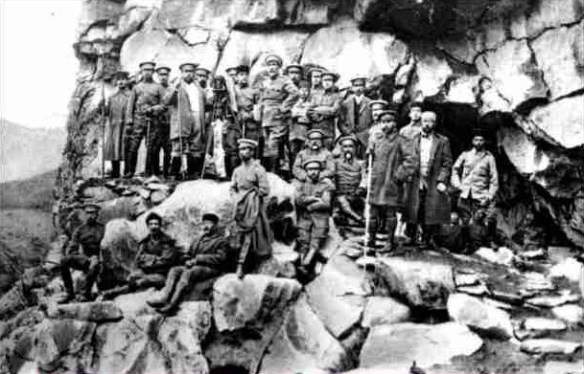
King Habibullah Khan with the military men of Afghanistan in early 1900s.
Historically, Afghanistan’s army evolved from traditional beginnings, but it was not until the reigns of Amir Dost Muhammad and Shir Ali Khan in the early nineteenth century that a process of modernization began. However, the army lacked the modern weaponry of the neighboring states and did not have a modern officer corps, for officers were appointed on the basis of loyalty rather than ability. Western technology and ideas only came to Afghanistan through means of prisoners of war or foreign mercenaries. Army troops were paid partially in cash and partially in kind and almost always in arrears, and recruitment was often accomplished through the seizure of able-bodied men, regardless of age. A militia of riflemen and tribal irregular forces enhanced the regular army. The modernization process was continued by Amir Shir Ali, who obtained a number of artillery pieces and some 5,000 Snider rifles in 1875, but civil war put an end to any other advancement. Amir Abdur Rahman was responsible for reequipping the regular army and expanding the production of weaponry in Afghanistan.
It was not until the beginning of the twentieth century (in 1904) that Amir Habibullah founded the Royal Military College, with the aim of creating a modern officer corps. The recruits were mostly the sons of Durrani chiefs, and the college was headed by a Turkish officer, Mahmud Sami, marking the beginning of Turkish influence in the Afghan army; this trend continued after World War I during the reign of King Amanullah, though advisers from Germany and other countries were also used. Amanullah’s army comprised an infantry of 38,000 men, a cavalry force of 8,000, and some 4,000 artillerymen, with mainly German field pieces.
Nadir Shah, on coming to power in 1930, reconstituted the army; established military schools for the artillery, cavalry, and infantry; increased pay for the armed forces; and improved accommodations and clothing. By 1936, the army, some 60,000 strong, utilized German, Italian, and Turkish officers and played a significant role in internal security. The troops were now regularly paid and housed in better accommodations, but this army was still inferior to the British India army in terms of equipment and levels of training. King Zahir continued the modernization process, for he realized that to ensure domestic stability and defend against external aggression, he needed a strong, modern force. The minister of war and commander-in-chief of the army, Shah Mahmud, embarked on a major program of reorganization and reequipping the troops. New officer training schools were established at Maimana and Mazar-i Sharif, and those in Kabul and Herat were expanded, with officers being sent abroad for additional training. Major weapons purchases were also made from Britain, Czechoslovakia, Germany, and Italy, together with the acquisition of tanks and aircraft to create the first mechanized forces. As a result of a voluntary enlistment process combined with compulsory service, the force had risen to 80,000 by 1936 and was consuming about half of the revenues of the government.
At the end of World War II, the force stood at 90,000 men, but by then its equipment was largely obsolete. Shah Mahmud, now prime minister, reduced the size of the army by half in order to focus on internal security and increased the size of the central police force. The Afghan government repeatedly tried to buy weapons from the United States, but these efforts were rebuffed, and in 1955, Prime Minister Muhammad Daud turned to the Soviet Union for assistance. In July 1956, the Soviet Union granted a loan of $32.4 million, which was used to modernize the army, but this arrangement resulted in Afghanistan becoming dependent on Soviet supplies and expertise, with nearly 4,000 Afghan personnel going to the USSR for training.